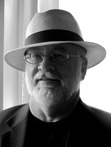Bruce DeSilva's Blog, page 35
July 18, 2013
“Mystery Girl” by David Gordon is Dark and Stylish
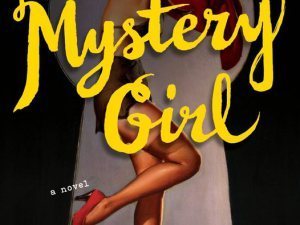 David Gordon’s literary novels are not only mysteries but explorations of the nature of storytelling. My Associated Press review of his latest, Mystery Girl, says in part:
David Gordon’s literary novels are not only mysteries but explorations of the nature of storytelling. My Associated Press review of his latest, Mystery Girl, says in part:
The novel explores not only storytelling but also issues of faith, personal identity, friendship and the decline of civilization. Readers should be warned that the author, whose many and varied previous jobs include writing for magazines with names like Hustler and Barely Legal, has inserted a fair amount of explicit sex. While the book is not a hard read, Gordon does ask more of readers than the typical thriller requires. He’s not just fooling around.
You can find the entire review here.
You can learn more about Gordon and his work here.


“Massacre Pond” Another Winner from Paul Doiron
 Here’s what I say about Massacre Pond, Paul Doiron’s new crime novel, in my Associated Press review:
Here’s what I say about Massacre Pond, Paul Doiron’s new crime novel, in my Associated Press review:
Doiron fashions a tense and clever mystery peopled by characters you could well meet by wandering into the wrong Down East bar. As usual, he peppers his superbly well-written yarn with evocative descriptions of the state he and Bowditch call home.
You can find the full text of the review here.
You can learn more about Paul and his work here.


June 18, 2013
A Review of Sara Gran’s Dark New Crime Novel
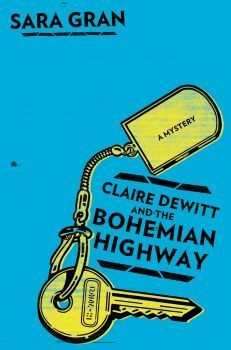 Sara Gran’s new crime novel, Claire DeWitt and the Bohemian Highway, takes noir to dark places rarely seen since and were writing a half-century ago.
Sara Gran’s new crime novel, Claire DeWitt and the Bohemian Highway, takes noir to dark places rarely seen since and were writing a half-century ago.
For my Associated Press review of this quirky and ambitious novel, please click here.


May 27, 2013
My Father’s War Story
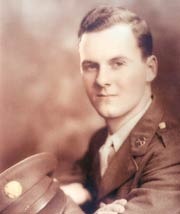 Every soldier who fought in World War II has a story. For Memorial Day in 2004, I told my father’s for the Associated Press, and every Memorial Day since I’ve re-posted it to honor him and the men and women he served with. You can find it here.
Every soldier who fought in World War II has a story. For Memorial Day in 2004, I told my father’s for the Associated Press, and every Memorial Day since I’ve re-posted it to honor him and the men and women he served with. You can find it here.


May 16, 2013
My Review of The New Easy Rawlins Novel by Walter Mosley
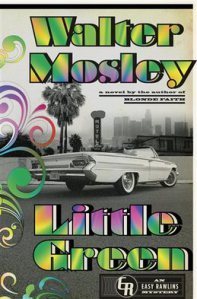 At the conclusion of Blonde Faith, Walter Mosley appeared to have killed off private detective Easy Rawlins, who had been a favorite of readers and critics alike. Now, six years later, he has brought Easy back in a new novel, Little Green.
At the conclusion of Blonde Faith, Walter Mosley appeared to have killed off private detective Easy Rawlins, who had been a favorite of readers and critics alike. Now, six years later, he has brought Easy back in a new novel, Little Green.
Easy’s resurrection will remind readers of the way Arthur Conan Doyle sent another beloved character to an apparent death in a plunge from Reichenback Falls in The Final Problem, only to bring him back to life in The Return of Sherlock Holmes.
You can read my Associated Press review of Mosley’s new novel here.
You can order the book here.
And you can learn more about the author here.


May 1, 2013
Richard Helms’s new crime novel, The Mojito Coast, is set...
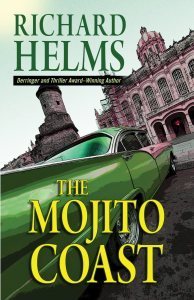 Richard Helms’s new crime novel, The Mojito Coast, is set in Miami and Cuba in the late 1950s, and everything about it, from the story to the writing, is a throwback.
Richard Helms’s new crime novel, The Mojito Coast, is set in Miami and Cuba in the late 1950s, and everything about it, from the story to the writing, is a throwback.
The hero, Cormac Loame, is one of those romantic private eyes with a cynical outer shell, like Mickey Spillane’s Mike Hammer or Richard S. Prather’s Shell Scott. “I usually don’t give a damn,” Loame says. “I take the money, I do the job, and I walk away and leave my clients to pick up the pieces of their lives.”
That’s how he likes to think of himself, but when it comes right down to it, he’ll walk away from the money and even risk his life to do the right thing.
Loame narrates his own story, and when he says things like “the hot poop and the straight skinny,” you can almost hear Cannonball Adderley blowing a smoky alto sax riff or Dooley Wilson playing a soulful “As Time Goes By” in the background.
The story begins when a Miami mobster known as The Madman hires Loam to track down his 14-year-old daughter, who has been abducted by an older man. But Loame soon learns that the facts are more complicated than that.
His investigation takes him to Havana, where American mobsters run the hotels and casinos, and where the rich who stand to lose everything in the revolution seem blithely unaware that Fidel Castro’s ragtag army has the forces of the country’s ruthless dictator, Fulgencio Batista, on the run.
Along the way, Loame runs into a long-lost love he’s never forgotten and discovers that she’s now the wife of an old enemy. He also encounters several historical figures from the era, tangling with mobster Meyer Lansky and getting a little help from mobster Santo Trafficante and author Ernest Hemingway.
The novel’s plot and tone bring to mind another romantic story about a hard-boiled character with a heart of gold who must choose between self-interest and honor in another war-torn city — Michael Curtiz’s classic 1942 movie, Cassablanca. And Helms’s tight, muscular prose is reminiscent of the largely-forgotten Prather, whose work is still very much worth reading.
Read The Mosquito Coast for the fine writing, the taut suspense, and as a fitting homage to crime fiction’s golden age.
You can order the novel here.
And you can learn more about Helms and his work here.


My Review of Bill Loehfelm’s Fine New Crime Novel
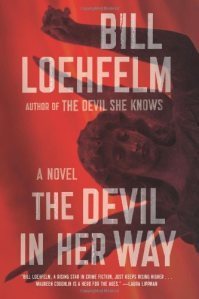 Post-Katrina New Orleans, with its thriving French Quarter, its still-ruined neighborhoods, its scandal-riddled police force and its often obnoxious tourists, has been the setting for a couple of outstanding crime novels, including James Lee Burke’s The Tin Roof Blowdown and Sara Gran’s quirky Claire DeWitt and the City of the Dead. Bill Loehfelm’s The Devil in Her Way measures up to that standard and then some.
Post-Katrina New Orleans, with its thriving French Quarter, its still-ruined neighborhoods, its scandal-riddled police force and its often obnoxious tourists, has been the setting for a couple of outstanding crime novels, including James Lee Burke’s The Tin Roof Blowdown and Sara Gran’s quirky Claire DeWitt and the City of the Dead. Bill Loehfelm’s The Devil in Her Way measures up to that standard and then some.
You can read my complete Associated Press review of the novel here.
You can order the book here.


April 29, 2013
Cat on Dogs
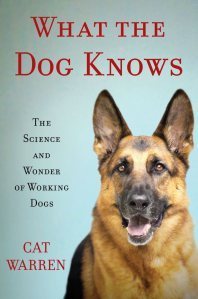 “I’ve grown more comfortable working with the dead. With parts of them, really. A few teeth, a vertebrae, a piece of carpet that lay underneath a body. One of my German shepherd’s standard training materials is dirt harvested from sites where decomposing bodies rested. Crack open a Mason jar filled with that dirt, and all I smell is North Carolina woods — musky darkness with a hit of mildewed alder leaves. Solo smells the departed.”
“I’ve grown more comfortable working with the dead. With parts of them, really. A few teeth, a vertebrae, a piece of carpet that lay underneath a body. One of my German shepherd’s standard training materials is dirt harvested from sites where decomposing bodies rested. Crack open a Mason jar filled with that dirt, and all I smell is North Carolina woods — musky darkness with a hit of mildewed alder leaves. Solo smells the departed.”
So begins What the Dog Knows, The Science and Wonder of Working Dogs by Cat Warren. It is, by any measure, a very fine non-fiction book.
Disclosure: Years ago, Cat and I were colleagues, but only briefly. She left her reporting job at The Hartford Courant shortly after I accepted an appointment as the paper’s first writing coach. But somehow she remembered me and sent me an advance copy of the book, which won’t hit the stores until October. I’m glad she did.
The picture on the cover is Solo, a dog she raised from puppyhood and trained to assist the police in searches for dead bodies — both murder victims and people who just wandered off and got fatally lost. To me, the photo suggests intelligence, strength, high spirits, and the potential for ferocity. As it turns out, Solo is of all that and more.
When Cat, who now teaches science journalism at North Carolina State University, first got him, he seemed destined to be a nuisance. He came from a litter of one, which dog lovers know usually spells trouble. Without littermates to roughhouse with, a puppy doesn’t learn that biting hurts. He fails to pick up the signals others give off when they’ve had enough. Such dogs often grow up to be rambunctious, aggressive, and too much for most pet owners to handle.
So Cat was desperate when she brought Solo to an experienced dog trainer who promptly branded him a “jackass.” He might not be well-suited to be a house pet, the trainer said, but his aggression and high energy were qualities that might make him a fine search dog. And so Cat and Solo set out together to make it happen.
The book’s subtitle, the Science and Wonder of Working Dogs, is a tad misleading. You will find nothing about herding or seeing eye dogs in these 351 pages. Instead, the author focuses on the military and police work that dogs do — tracking, attacking, drug-sniffing, explosives detection, and, most of all, locating the dead.
Cat was a fine journalist, and it shows. Her painstaking research on the history and science of working dogs debunks myths and explains what is known–and how much remains unknown–about canine abilities and behavior. By combining this hard information with anecdotes about training Solo, accounts of searching the North Carolina woods for dead bodies, and the stories of other trainers and their dogs, she has produced a book that is both informative and entertaining. Although her love for Solo is palpable, she remains analytical and clear-headed, never romanticizing what he or other working dogs do.
And, as the first passage in this review demonstrates, she tells it all in tight, precise prose that is truly a pleasure to read.
You can order the book in advance here.


April 23, 2013
T. Jefferson Parker’s “The Famous and the Dead.” My Review.
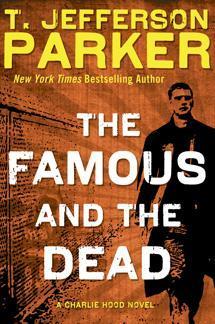 With “The Famous and the Dead,” T. Jefferson Parker brings his six-novel saga about Charlie Hood, an LA lawman hellbent on disrupting gunrunning along the Mexican border, to a conclusion.
With “The Famous and the Dead,” T. Jefferson Parker brings his six-novel saga about Charlie Hood, an LA lawman hellbent on disrupting gunrunning along the Mexican border, to a conclusion.
The new crime novel, like the series as a whole, is ambitious, daring, at once brilliant and maddeningly uneven — and well worth reading. You can read my Associated Press review here.
You can read more about Parker and his work here.


April 17, 2013
My Son Jeremy’s Groundbreaking Research on Human Evolution

Jeremy is the one in the middle
I always knew he was going to do something special.
As a toddler, he was fascinated by the world and everything in it. He carried on startlingly adult conversations before he was old enough for kindergarten. He was always the smartest one in school, sometimes getting in trouble for surreptitiously reading library books during classes that had nothing new to teach him.
He threw a perfect game against Little League All Stars. At age 11, competing against older kids on the floor of the old Boston Garden during half-time at a Celtics game, he won the NBA’s New England regional basketball shootout. He helped organize a road race in honor of a high-school friend killed in a car crash.
He went to Cornell, where he hoped to study astronomy under Carl Sagan. He abandoned astronomy for biology and anthropology, then earned his Phd. at the University of Michigan, where he honed his research skills in the hominid evolution.
 He married an incredible woman, and his first born just might be the world’s most beautiful fraternal twins.
He married an incredible woman, and his first born just might be the world’s most beautiful fraternal twins.
Now he is a professor at Boston University, where his students, making their feelings known on the “Rate My Professor” website, give him high marks for helpfulness and clarity, complain about how tough he is on them, and rate him a chilli pepper — the highest rating for “hottness.”
Today, Professor Jeremy DeSilva is a rising star in the field of early human evolution, traveling to Africa for field work and 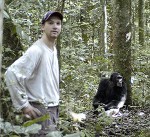 specializing in the locomotion of our ancient ancestors and relatives. His research as part of a team studying a stunning group of South African fossils is revolutionizing our understanding of who they were, how they lived, and how modern humans came to be.
specializing in the locomotion of our ancient ancestors and relatives. His research as part of a team studying a stunning group of South African fossils is revolutionizing our understanding of who they were, how they lived, and how modern humans came to be.
You can read an accessible account about his research in this recent Boston Globe article.
You can hear him talk about his most recent discoveries in this Science Magazine podcast.
And you can learn more about these discoveries in this Duke University podcast, Jeremy’s part in it starting three minutes in.
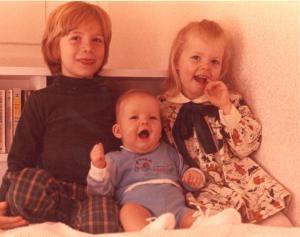
Richard, Melanie, and Jeremy
His older brother and sister are amazing, too. Richard, an investment expert, is one of the most caring people I know. He runs in the Boston Marathon, including this year’s tragic race, to raise money for cancer research. Melanie, a passionate advocate for the underprivileged and for women’s issues, manages marketing and recruitment for the University Without Walls at the University of Massachusetts, a program that brings adult dropouts back to college to finish their degrees.
And the three of them are teaching me what it means to be a great parent.



